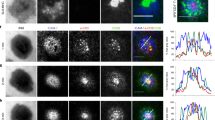Abstract
THE CD2 T lymphocyte-surface glycoprotein serves to mediate adhesion between T lymphocytes and their cognate cellular partners which express the specific ligand LFA-3 (refs 1–3). In addition, CD2 by itself or in conjunction with T-cell receptor stimulation, transduces signals resulting in T-lymphocyte activation4–8. One or both of these functions seems to be physiologically important, given that certain anti-CD2 monoclonal antibodies block T-cell activation9,10 and that antigen-responsive memory T cells express a high level of CD2 relative to virgin T cells, which are largely antigen-unresponsive11. Nevertheless, the contribution of the individual CD2 functions in T-cell responses has not been independently examined. To this end, human CD2 complementary DNAs encoding an intact LFA-3-binding adhesion domain, but lacking a functional cytoplasmic signal transduction element (CD2trans-), were introduced into an ovalbumin-specific, I–Ad restricted murine T-cell hybridoma. The antigen-specific response of T hybridoma cells expressing human CD2trans- protein was enhanced up to 400% when the human LFA-3 ligand was introduced into the I–Ad expressing murine antigen-presenting cells. In contrast, no augmentation was observed if human LFA-3 was absent or expressed on a third-party cell lacking the I–Ad restriction element. These results directly demonstrate the functional significance of adhesion events mediated between CD2 on the antigen-responsive T lymphocyte and LFA-3 on the presenting cell in optimizing antigen-specific T-cell activation.
This is a preview of subscription content, access via your institution
Access options
Subscribe to this journal
Receive 51 print issues and online access
$199.00 per year
only $3.90 per issue
Buy this article
- Purchase on Springer Link
- Instant access to full article PDF
Prices may be subject to local taxes which are calculated during checkout
Similar content being viewed by others
References
Selvaraj, P. et al. Nature 326, 400–403 (1987).
Shaw, S. et al. Nature 323, 262–264 (1986).
Hunig, T. et al. J. exp. Med. 162, 890–901 (1985).
Meuer, S. C. et al. Cell 36, 897–906 (1984).
Brottier, J., Boumsell, L., Gelin, C. & Bernard, A. J. Immun. 136, 1624–1631 (1985).
Hunig, T., Tiefenthaler, G., Meyer zum Buschenfelde, K. H. & Meuer, S. C. Nature 326, 298–301 (1987).
Yang, S. Y., Chouaib, S. & Dupont, B. J. Immun. 137, 1097–1100 (1986).
Bierer, B., Peterson, A., Gorga, J. C., Hermann, S. H. & Burakoff, S. J. J. exp. Med. 168, 1145–1156 (1988).
Palacios, R. & Martinez-Maza, O. J. Immun. 129, 2479–2485 (1982).
Tadmori, W. et al. J. Immun. 136, 1155–1160 (1986).
Sanders, M. E. et al. J. Immun. 140, 1401–1407 (1988).
He Q., Beyers, A. D., Barclay, A. N. & Williams, A. F. Cell 54, 979–984 (1988).
Chang, H. C. et al. J. exp. Med. (in the press).
Sayre, P. H., Hussey, R. E., Chang, H. C., Ciardelli, T. L. & Reinhaerz, E. L. J. exp. Med. 169, 995–1009 (1989).
Nagafuchi, A. & Takeichi, M. EMBO J. 7, 3679–3684 (1988).
Yagita, H. et al. Proc. natn. Acad. Sci. U.S.A. 86, 645–649 (1989).
Wallner, B. et al. J. exp. Med. 166, 925–932 (1988).
Denning, S. M. et al. J. Immun. 139, 2573–2578 (1987).
Sleckman, B. P. et al. J. Immun. 141, 49–54 (1988).
Sayre, P. H. et al. Proc. natn. Acad. Sci. U.S.A. 84, 2941–2945 (1987).
Haskins, K. et al. J. exp. Med. 157, 1149–1169 (1983).
Johnson, G. D. & Holborow, E. J. in Handbook of Experimental Immunology Vol. IV (ed. Weird, D.) 1–21 (Oxford University Press, 1986).
Author information
Authors and Affiliations
Rights and permissions
About this article
Cite this article
Moingeon, P., Chang, HC., Wallner, B. et al. CD2-mediated adhesion facilitates T lymphocyte antigen recognition function. Nature 339, 312–314 (1989). https://doi.org/10.1038/339312a0
Received:
Accepted:
Issue Date:
DOI: https://doi.org/10.1038/339312a0
This article is cited by
-
Pediococcus pentosaceus MIANGUAN Enhances the Immune Response to Vaccination in Mice
Probiotics and Antimicrobial Proteins (2024)
-
Cluster of differentiation antigens: essential roles in the identification of teleost fish T lymphocytes
Marine Life Science & Technology (2022)
-
IFN signaling and neutrophil degranulation transcriptional signatures are induced during SARS-CoV-2 infection
Communications Biology (2021)
-
Destructive Roles of Fibroblast-like Synoviocytes in Chronic Inflammation and Joint Damage in Rheumatoid Arthritis
Inflammation (2021)
-
Tetraspanin CD53: an overlooked regulator of immune cell function
Medical Microbiology and Immunology (2020)
Comments
By submitting a comment you agree to abide by our Terms and Community Guidelines. If you find something abusive or that does not comply with our terms or guidelines please flag it as inappropriate.



